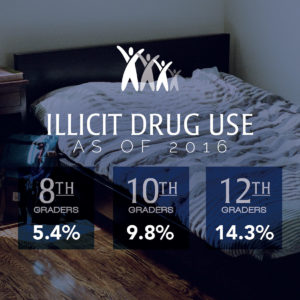Search by category, archive or keyword

Identifying a young family member struggling with drug use, misuse, and addiction is a key part of seeking early treatment. Family intervention and support can be important in the first steps toward recovery, especially in vulnerable teenagers and young adults.
Discovering that your child has a drug problem can feel overwhelming, but with the right tools, knowledge, and professional help, you can become a source of light and guidance for the journey ahead. Spotting drug use in your family members and drug paraphernalia around the home are important skills every parent should have.
Facts on Teenage Drug Use
According to data from the Department of Health and Human Services, most adolescents engage in illicit drug use occasionally, with few doing so regularly. Parents should not downplay occasional use, however, as it can easily turn into an addiction and/or overdose.
The data shows that by 12th grade, almost half of adolescents report illicit drug use at least once. The most common illicit substance for abuse in this data set is marijuana, followed by prescription medications, glues, and aerosols. Parents can lower the risk of drug use in the home by reducing the availability of these last three substances.

According to the 2015–2016 Monitoring the Future survey of drug use among America’s youth, the use of illicit drugs has declined overall. The data shows that drug use is at its lowest level in the history of the survey.
Illicit drug use as of 2016 was at 5.4% among 8th graders, 9.8% among 10th graders, and 14.3% among 12th graders. These numbers are down from peak highs of 12.6%, 18.4%, and 21.6% across different years, respectively. Yet the report also showed an unchanged amount of marijuana use in 12th graders and a general decline in the perceived risk of harm from using substances. Changing attitudes reflect the need for constant vigilance to keep drugs and drug paraphernalia out of the household.
Common Signs of Adolescent Drug Use

There are physical, emotional, and mental symptoms of illicit drug use parents can often spot in their children.
Some of the most noticeable effects of drug use are physical changes an adolescent may suddenly display, such as:
- Bloodshot or glazed eyes
- Pupils that are dilated or constricted
- Abrupt weight changes
- Physical signs of a drug entrance site, such as bruising or infection
Depending on the drug, an adolescent struggling with addiction may lose or gain weight suddenly and stop taking care of personal hygiene.
Aside from physical signs, be on the lookout for mental and emotional changes in your teen. People struggling with addiction can undergo changes in personality and behavioral symptoms, especially as he or she becomes more dependent on the drugs.
An adolescent with an addiction may have trouble forming coherent thoughts. His or her grades may begin to fall, and teachers may complain that your adolescent fails to pay attention or falls asleep in class.
Signs such as lethargy, changes in attitude, increased aggression, depression, and changes in habits or priorities may point to a substance misuse problem. Hanging out with a “bad crowd” or a sudden change in a social network may also point to drug use, as well as involvement in criminal activity.
How to Spot Drug Paraphernalia
Drug paraphernalia, or items often involved in drug use, is a good sign that your adolescent is abusing illicit drugs. Paraphernalia can include anything your adolescent has modified to make or use drugs or conceal them from you.
Common items relating to marijuana use include the following:
- Rolling papers
- Pipes
- Grinders
- Small metal clips
- Lighters or matches
- Small plastic baggies (used for holding the drug)
Look for pipes made using household products such as apples, highlighters, or bottles. A purchased marijuana pipe or bong may resemble a decorative trinket or souvenir made from colorful blown glass.
Paraphernalia common to inhaled drugs, such as cocaine, include:
- Razor blades (used to chop the drug)
- Small mirrors
- Spoons
- Rolled-up papers
- Dollar bills
- Straws
Signs of inhalant abuse with gasoline, painter thinner, or solvents include finding empty cans of these products you didn’t use, nozzles, balloons, or cloths dipped in chemicals. Items such as needles, syringes, medical tubing, spoons, lighters, or Bunsen burners may all point to the use of injectable drugs such as heroin.

How to Help Your Child
If you notice your child shows signs of drug use, or if you find drug paraphernalia in your household, learn the right way to help. It is vital to handle the situation with care and support, or you run the risk of pushing your teen away.
Partner with Family First Intervention for professional assistance and advice when it comes to helping your teen recover from an illicit drug problem.
Let Family First Intervention Assist You with Speaking to Your Child about the Dangers of Addiction:
An intervention is not about how to control the substance user; it is about how to let go of believing you can.
“The most formidable challenge we professionals face is families not accepting our suggested solutions. Rather, they only hear us challenging theirs. Interventions are as much about families letting go of old ideas as they are about being open to new ones. Before a family can do something about the problem, they must stop allowing the problem to persist. These same thoughts and principles apply to your loved one in need of help.”
Mike Loverde, MHS, CIP


